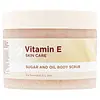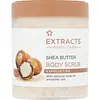What's inside
What's inside
 Key Ingredients
Key Ingredients

 Benefits
Benefits

 Concerns
Concerns

 Ingredients Side-by-side
Ingredients Side-by-side

Glycerin
HumectantCaprylic/Capric Triglyceride
MaskingMaris Sal
Skin ConditioningSodium Chloride
MaskingSucrose
HumectantGlyceryl Stearate
EmollientPEG-100 Stearate
Polysorbate 20
EmulsifyingJuglans Regia Shell Powder
AbrasiveButyrospermum Parkii Butter
Skin ConditioningPrunus Amygdalus Dulcis Oil
Skin ConditioningVitis Vinifera Seed Oil
EmollientTocopheryl Acetate
AntioxidantParfum
MaskingPrunus Armeniaca Seed Powder
AbrasiveWater
Skin ConditioningPEG-35 Castor Oil
EmulsifyingTocopherol
AntioxidantAesculus Hippocastanum Seed Extract
Skin ConditioningAlcohol Denat.
AntimicrobialCalcium Pantothenate
Inositol
HumectantLinoleic Acid
CleansingRetinyl Palmitate
Skin ConditioningBiotin
AntiseborrhoeicBenzyl Alcohol
PerfumingLinalool
PerfumingBenzyl Salicylate
PerfumingLimonene
PerfumingGlycerin, Caprylic/Capric Triglyceride, Maris Sal, Sodium Chloride, Sucrose, Glyceryl Stearate, PEG-100 Stearate, Polysorbate 20, Juglans Regia Shell Powder, Butyrospermum Parkii Butter, Prunus Amygdalus Dulcis Oil, Vitis Vinifera Seed Oil, Tocopheryl Acetate, Parfum, Prunus Armeniaca Seed Powder, Water, PEG-35 Castor Oil, Tocopherol, Aesculus Hippocastanum Seed Extract, Alcohol Denat., Calcium Pantothenate, Inositol, Linoleic Acid, Retinyl Palmitate, Biotin, Benzyl Alcohol, Linalool, Benzyl Salicylate, Limonene
Water
Skin ConditioningCetearyl Alcohol
EmollientCetyl Alcohol
EmollientGlycerin
HumectantPrunus Amygdalus Dulcis Shell Powder
AbrasiveOryza Sativa Germ Powder
AbrasiveCeteareth-20
CleansingCetearyl Isononanoate
EmollientDimethicone
EmollientParfum
MaskingButyrospermum Parkii Butter
Skin ConditioningCarbomer
Emulsion StabilisingDisodium EDTA
Xanthan Gum
EmulsifyingSodium Hydroxide
Buffering2-Bromo-2-Nitropropane-1,3-Diol
PreservativeMagnesium Nitrate
Methylchloroisothiazolinone
PreservativeMagnesium Chloride
Methylisothiazolinone
PreservativeLinalool
PerfumingWater, Cetearyl Alcohol, Cetyl Alcohol, Glycerin, Prunus Amygdalus Dulcis Shell Powder, Oryza Sativa Germ Powder, Ceteareth-20, Cetearyl Isononanoate, Dimethicone, Parfum, Butyrospermum Parkii Butter, Carbomer, Disodium EDTA, Xanthan Gum, Sodium Hydroxide, 2-Bromo-2-Nitropropane-1,3-Diol, Magnesium Nitrate, Methylchloroisothiazolinone, Magnesium Chloride, Methylisothiazolinone, Linalool
Ingredients Explained
These ingredients are found in both products.
Ingredients higher up in an ingredient list are typically present in a larger amount.
This ingredient is also known as shea butter. It is an effective skin hydrator and emollient.
Emollients help soothe and soften your skin. It does this by creating a protective film on your skin. This barrier helps trap moisture and keeps your skin hydrated. Emollients may be effective at treating dry or itchy skin.
Shea butter is rich in antioxidants. Antioxidants help fight free-radicals, or molecules that may harm the body. It is also full of fatty acids including stearic acid and linoleic acid. These acids help replenish the skin and keep skin moisturized.
While Shea Butter has an SPF rating of about 3-4, it is not a sunscreen replacement.
Shea butter may not be fungal acne safe. We recommend speaking with a professional if you have any concerns.
Learn more about Butyrospermum Parkii ButterGlycerin is already naturally found in your skin. It helps moisturize and protect your skin.
A study from 2016 found glycerin to be more effective as a humectant than AHAs and hyaluronic acid.
As a humectant, it helps the skin stay hydrated by pulling moisture to your skin. The low molecular weight of glycerin allows it to pull moisture into the deeper layers of your skin.
Hydrated skin improves your skin barrier; Your skin barrier helps protect against irritants and bacteria.
Glycerin has also been found to have antimicrobial and antiviral properties. Due to these properties, glycerin is often used in wound and burn treatments.
In cosmetics, glycerin is usually derived from plants such as soybean or palm. However, it can also be sourced from animals, such as tallow or animal fat.
This ingredient is organic, colorless, odorless, and non-toxic.
Glycerin is the name for this ingredient in American English. British English uses Glycerol/Glycerine.
Learn more about GlycerinLinalool is a fragrance and helps add scent to products. It's derived from common plants such as cinnamon, mint, citrus, and lavender.
Like Limonene, this ingredient oxidizes when exposed to air. Oxidized linalool can cause allergies and skin sensitivity.
This ingredient has a scent that is floral, spicy tropical, and citrus-like.
Learn more about LinaloolParfum is a catch-all term for an ingredient or more that is used to give a scent to products.
Also called "fragrance", this ingredient can be a blend of hundreds of chemicals or plant oils. This means every product with "fragrance" or "parfum" in the ingredients list is a different mixture.
For instance, Habanolide is a proprietary trade name for a specific aroma chemical. When used as a fragrance ingredient in cosmetics, most aroma chemicals fall under the broad labeling category of “FRAGRANCE” or “PARFUM” according to EU and US regulations.
The term 'parfum' or 'fragrance' is not regulated in many countries. In many cases, it is up to the brand to define this term.
For instance, many brands choose to label themselves as "fragrance-free" because they are not using synthetic fragrances. However, their products may still contain ingredients such as essential oils that are considered a fragrance by INCI standards.
One example is Calendula flower extract. Calendula is an essential oil that still imparts a scent or 'fragrance'.
Depending on the blend, the ingredients in the mixture can cause allergies and sensitivities on the skin. Some ingredients that are known EU allergens include linalool and citronellol.
Parfum can also be used to mask or cover an unpleasant scent.
The bottom line is: not all fragrances/parfum/ingredients are created equally. If you are worried about fragrances, we recommend taking a closer look at an ingredient. And of course, we always recommend speaking with a professional.
Learn more about ParfumWater. It's the most common cosmetic ingredient of all. You'll usually see it at the top of ingredient lists, meaning that it makes up the largest part of the product.
So why is it so popular? Water most often acts as a solvent - this means that it helps dissolve other ingredients into the formulation.
You'll also recognize water as that liquid we all need to stay alive. If you see this, drink a glass of water. Stay hydrated!
Learn more about Water